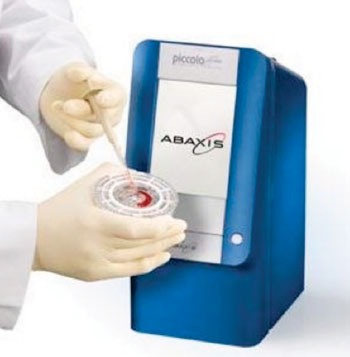Biomarker Correlates With Survival for Pediatric Ebola Patients
By LabMedica International staff writers
Posted on 09 Oct 2014
Outbreaks of Ebola virus disease (EVD) occur sporadically in Africa and are associated with high case-fatality rates yet children have been less affected than adults.Posted on 09 Oct 2014
The term hemorrhagic fever has been used to describe this disease process because hemorrhagic manifestations develop in many patients during the course of illness which is characterized by abrupt onset of fever, fatigue, headache, myalgia, and gastrointestinal distress 3 to 13 days after exposure to the virus.

Image: Piccolo comprehensive metabolic reagent disk and the Piccolo Xpress Chemistry Analyzer (Photo courtesy of Abaxis).
A team of scientists at Emory University (Atlanta, GA, USA) obtained serum samples 55 pediatric and 161 adult laboratory-confirmed cases from an outbreak in Gulu district (Uganda) that occurred in 2000 and 2001. The team used a series of multiplex assays to measure the concentrations of 55 serum analytes in specimens from patients from that outbreak to identify biomarkers specific to pediatric disease.
The 26-plex bead-based assay (Affymetrix; Santa Clara, CA, USA) was performed for chemokines and cytokines as well as a 2-plex assay for D-dimer and tissue plasminogen activator. Single-plex assays for ferritin and cortisol and 2-plex assays for tissue factor (TF) and thrombomodulin (Millipore; Billerica, MA, USA) were also implemented. Enzyme-linked immunosorbent assays (ELISA) were used to quantify mannose-binding lectin (Hycult Biotech; Plymouth Meeting, PA, USA) and total immunoglobulin G (IgG) (eBioscience; San Diego, CA, USA). A Piccolo comprehensive metabolic reagent disk was run on the Piccolo Xpress Chemistry Analyzer (Abaxis; Union City, CA, USA) to determine serum chemistry values.
Pediatric patients who survived had higher levels of the chemokine regulated on activation, normal T-cell expressed and secreted marker and lower levels of plasminogen activator inhibitor 1, soluble intracellular adhesion molecule, and soluble vascular cell adhesion molecule than did pediatric patients who died. Adult patients had similar levels of these analytes regardless of outcome. The regulated on activation, normal T cell expressed and secreted chemokine (RANTES), also known as Chemokine (C-C motif) ligand 5, was the only factor studied that demonstrated an association with higher survival rates in children.
The authors concluded that different pathophysiologic mechanisms of disease may be at work in pediatric patients, and children may benefit from different treatment than their adult counterparts. Therapeutic interventions targeted at decreasing endothelial activation in pediatric patients early during the course of infection might include drugs that affect endothelial activation, such as statins. The study was published in the October 2014 issue of the journal Emerging Infectious Diseases.
Related Links:
Emory University
Affymetrix
Abaxis













